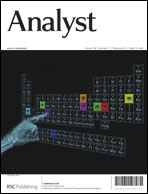Real-time electrochemical detection of pathogen DNA using electrostatic interaction of a redox probe†
Abstract
Electrostatic redox probes interaction has been widely rendered for DNA quantification. We have established a proof-of-principle by using the ruthenium hexaamine molecule [Ru(NH3)6]3+. We have applied this method for real-time electrochemical monitoring of a loop mediated isothermal amplification (LAMP) amplicon of target genes of Escherichia coli and Staphylococcus aureus by


 Please wait while we load your content...
Please wait while we load your content...